| |
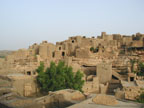  The Dogon people live throughout this area,
all the way back to Djenne, but today we heading into the heart of
Dogon country. The road is everything but paved. At times it is smooth
packed clays but this is alternated with rocky, rutted, sandy, and
gravel. While the route is relatively flat we passed rocky The Dogon people live throughout this area,
all the way back to Djenne, but today we heading into the heart of
Dogon country. The road is everything but paved. At times it is smooth
packed clays but this is alternated with rocky, rutted, sandy, and
gravel. While the route is relatively flat we passed rocky
 razor back
ridges and in the distance there are various sizes and shapes of clay
monoliths that added character and fun to the horizon. Because donkey
carts use the route it is technically a double-track, but because one
track is generally better than the other, it is more like single track
riding as we wove between the trees, bushes and other objects. razor back
ridges and in the distance there are various sizes and shapes of clay
monoliths that added character and fun to the horizon. Because donkey
carts use the route it is technically a double-track, but because one
track is generally better than the other, it is more like single track
riding as we wove between the trees, bushes and other objects.
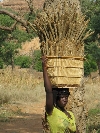 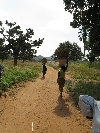
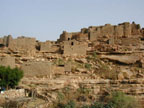 It is a little more difficult to figure out the dynamics of the
economy and the culture here. There is a lot of planted land,
generally with millet. But we only saw people occasionally and for
miles and miles, until we were near our destination, there seemed to
be no housing, or it was well hidden. The are well used donkey tracks
heading off at regular intervals that are well enough used that they
probably single the route to a village. It is a little more difficult to figure out the dynamics of the
economy and the culture here. There is a lot of planted land,
generally with millet. But we only saw people occasionally and for
miles and miles, until we were near our destination, there seemed to
be no housing, or it was well hidden. The are well used donkey tracks
heading off at regular intervals that are well enough used that they
probably single the route to a village.
Are destination is Niongono. Our first stop was the school, which
is in the flat lands, on the outskirts of the village.




  From a distance
Niongono looks like a castle
perched on a small mountain. On closer inspection it is not a castle,
but a village of individual houses snuggled on the slopes of the hill.
Even if it is not a castle, it still has a medieval air to it. There
is no running water or electricity, the buildings are made of stone
and clay, any windows are small and all From a distance
Niongono looks like a castle
perched on a small mountain. On closer inspection it is not a castle,
but a village of individual houses snuggled on the slopes of the hill.
Even if it is not a castle, it still has a medieval air to it. There
is no running water or electricity, the buildings are made of stone
and clay, any windows are small and all
  the transport is by foot or
donkey. Throughout much of the Dogon country the villages have moved
off the hills, that historically provided some protection, onto the
flatlands, but most of the population of Niongono still lives on the
hill. There are only a couple of approaches to the fortress so these
carry a pretty constant stream of people hauling water, wood and farm
produce from the flatlands up into the village. the transport is by foot or
donkey. Throughout much of the Dogon country the villages have moved
off the hills, that historically provided some protection, onto the
flatlands, but most of the population of Niongono still lives on the
hill. There are only a couple of approaches to the fortress so these
carry a pretty constant stream of people hauling water, wood and farm
produce from the flatlands up into the village.      
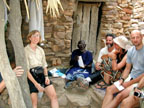 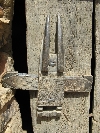 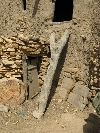  As good manners dictates, one of our first activities was to visit
and great the town chief. He is getting on in years, but when he was
young he had traveled some but not outside of Africa. He had a variety
of questions about the rest of the world and always his reference
seemed to be, "How far is that from Mecca?" Among his
treasures was a box filled with letters, photographs and memorabilia
from past Western visitors. As good manners dictates, one of our first activities was to visit
and great the town chief. He is getting on in years, but when he was
young he had traveled some but not outside of Africa. He had a variety
of questions about the rest of the world and always his reference
seemed to be, "How far is that from Mecca?" Among his
treasures was a box filled with letters, photographs and memorabilia
from past Western visitors.
  After this visit we had the "key to the city" and could
walk around unobstructed and unharassed, though we often had youthful
shadows that studied our every move and our every gadget - it was only
fair we were studying them. If the eyes became to much we could
retreat to the courtyard of our host, which was shaded by a large tree
and where After this visit we had the "key to the city" and could
walk around unobstructed and unharassed, though we often had youthful
shadows that studied our every move and our every gadget - it was only
fair we were studying them. If the eyes became to much we could
retreat to the courtyard of our host, which was shaded by a large tree
and where
 the children were kept generally out of eyesight. the children were kept generally out of eyesight.
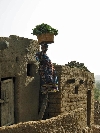  Very little about today's ride or being a resident of Niongono
alludes to there being an industrial age someplace else on the planet.
It is like Very little about today's ride or being a resident of Niongono
alludes to there being an industrial age someplace else on the planet.
It is like
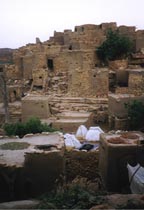 stepping back in time a couple centuries. About the only
person in the village that is literate in French is the schoolteacher.
He didn't spend much time with us, but just sitting in the center of
the village for a while or taking a slow stroll around was an eyeful
and an education in itself. This is one of my favorite days. stepping back in time a couple centuries. About the only
person in the village that is literate in French is the schoolteacher.
He didn't spend much time with us, but just sitting in the center of
the village for a while or taking a slow stroll around was an eyeful
and an education in itself. This is one of my favorite days. |
Addendum: President Obama logo

wear reaches Niongono
|

 The Dogon people live throughout this area,
all the way back to Djenne, but today we heading into the heart of
Dogon country. The road is everything but paved. At times it is smooth
packed clays but this is alternated with rocky, rutted, sandy, and
gravel. While the route is relatively flat we passed rocky
The Dogon people live throughout this area,
all the way back to Djenne, but today we heading into the heart of
Dogon country. The road is everything but paved. At times it is smooth
packed clays but this is alternated with rocky, rutted, sandy, and
gravel. While the route is relatively flat we passed rocky
 razor back
ridges and in the distance there are various sizes and shapes of clay
monoliths that added character and fun to the horizon. Because donkey
carts use the route it is technically a double-track, but because one
track is generally better than the other, it is more like single track
riding as we wove between the trees, bushes and other objects.
razor back
ridges and in the distance there are various sizes and shapes of clay
monoliths that added character and fun to the horizon. Because donkey
carts use the route it is technically a double-track, but because one
track is generally better than the other, it is more like single track
riding as we wove between the trees, bushes and other objects.





























